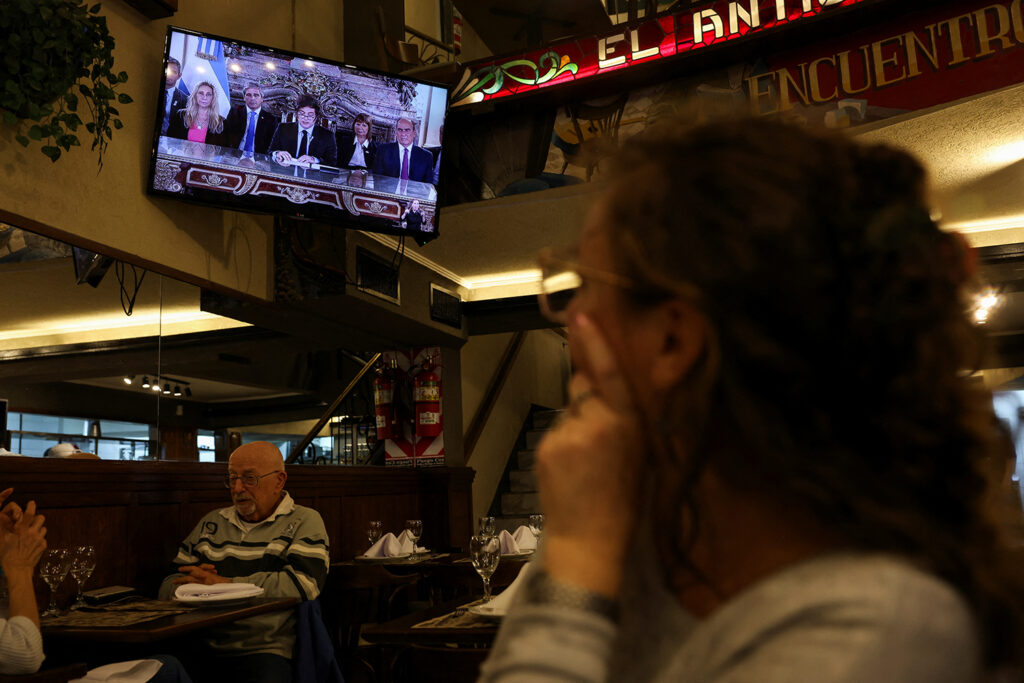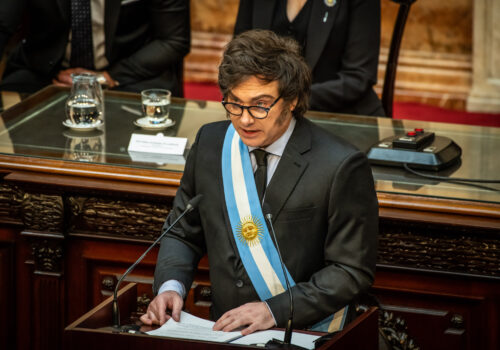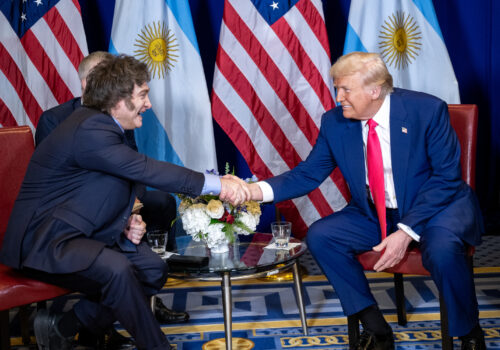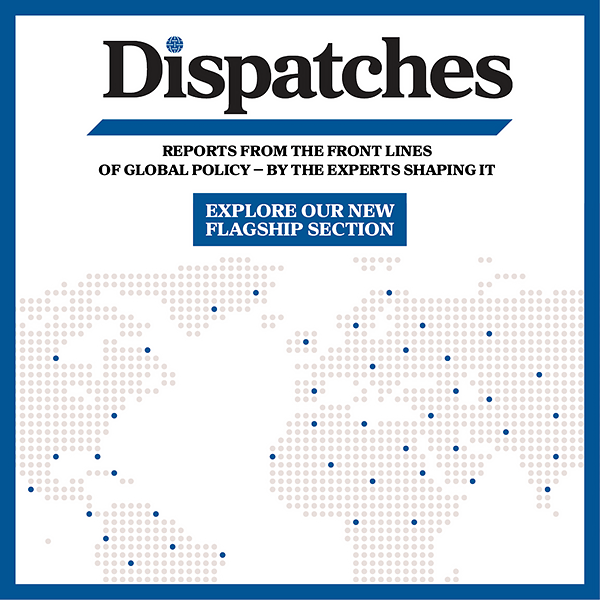Buenos Aires is getting a boost. On April 11, the International Monetary Fund (IMF) approved a twenty-billion-dollar, four-year loan to Argentina, with the first twelve billion dollars arriving on April 15. The Inter-American Development Bank (IDB) and World Bank followed up by releasing another $22 billion in financing. In response, Argentina lifted large elements of its currency and capital controls, known as the “cepo,” which had long stifled investment and growth. Marking the twenty-third IMF loan to Argentina since the 1950s, the deal comes as libertarian President Javier Milei has dramatically cut Argentina’s spending in an effort to stabilize government finances. As global financial leaders prepare to descend on Washington for next week’s IMF-World Bank Spring Meetings, Atlantic Council experts answer four pressing questions about Argentina’s latest financial rescue and the road ahead.
1. What did the IMF agree to and what is being asked of Argentina?
Argentina approached the IMF for a new program because it wanted to unwind strict controls on capital outflows that have been an obstacle for foreign investment over many years. Removing these controls could have led to a sharp depreciation in the exchange rate, which is why the government needed to bolster its foreign exchange reserves with IMF funds, both to instill confidence and to intervene, if necessary, to maintain orderly market conditions.
The IMF was willing to provide Argentina with another loan of twenty billion dollars, coming on top of the outstanding forty billion dollars that Argentina will still need to repay. About eleven billion dollars of the new loan will be used to cover loan repayments to the IMF over the next four years. However, given the substantial frontloading of the IMF’s disbursements, the IMF’s peak exposure to Argentina will increase to some $58 billion in 2026. The program is conditioned on the path of the government’s primary deficit, a halt on central bank financing of the government, and a floor under social expenditure, among other conditions. As a precondition for program approval, the government committed to let the exchange rate float within a band of 1,000 to 1,400 pesos per US dollar and to abandon current and capital account exchange rate restrictions.
—Martin Mühleisen is a nonresident senior fellow at the Atlantic Council’s GeoEconomics Center and a former IMF official with decades of experience in economic crisis management and financial diplomacy.
What is striking is not only the scale of the program and disbursements, but that both parties have agreed to a plan that presents a roadmap with significant support from other multilaterals (the IDB and World Bank) as well as from the market. The accumulation of reserves and the continuation of Argentina’s fiscal consolidation, as well as the elimination of the cepo, are all objectives that the market and investors have been pushing for as the next step of the Milei administration’s impressive reform agenda, as we explained in December. Now, this new agreement appears to be a roadmap to assuage investor concerns and strengthen the country’s ability to deepen its reforms and respond to global uncertainty.
—Jason Marczak is vice president and senior director of the Atlantic Council’s Adrienne Arsht Latin America Center.
2. What does this mean for Argentina’s economy?
One of the key takeaways is that Argentina, and the Milei administration more specifically, now has the ability to think about the next chapter in its stabilization and reform agenda, with an emphasis on the latter. With the limitations that the agreement sets on the central bank’s ability to intervene in the foreign currency market (so long as there are no wild moves in the exchange rate) the bank should now be able to shore up its reserves by focusing on the acquisition, rather than the sale, of dollars. This will likely be done conservatively to prevent an upward pressure on the local dollar value, but it is good news in the medium term for Argentina’s reserves and for the sustainability of its debt.
Looking ahead into 2026, if the exchange rate holds within the agreed-to bands and the country acquires significant reserves, this will allow Argentina to reenter international capital markets and access private financing at lower rates (because of the lower risk that more reserves entail). This, in turn, would allow the country to meet its obligations with foreign creditors while seeing its country risk fall further, finally bringing down its sovereign risk premiums to levels closer to the regional average. This is a necessary condition to unleash the foreign investment that the country needs to fulfill its potential.
—Jason Marczak
The reforms of the Milei government have boosted confidence in its ability to lift Argentina’s economy on a durably higher growth path at lower inflation. To maintain public support after this past year’s painful but necessary budget-cutting exercise, it is essential that private investment now kicks in to support employment and growth over the coming years. The removal of capital controls is an important component of this plan, along with other structural reforms that are partly covered by the program.
However, the exchange rate is still overvalued, which by itself is reducing Argentina’s attractiveness as an investment destination, and a rapid exchange rate adjustment could lead to a resurgence in inflation. This could undermine economic as well as political sentiments, proving fatal for the overall reform effort. The IMF’s support could therefore be critical for the government to maintain its market-friendly policy course.
—Martin Mühleisen
3. Is this a vindication of Milei’s stabilization plan? What might this mean for Argentina’s politics?
The IMF has been in a difficult position. The loan will significantly increase its already large exposure to Argentina, which has a history of difficult and controversial programs with the IMF. In case of a global downturn, there is a risk that growth may again disappoint, leading to further peso depreciation and resurgent inflation. Given the political significance of the exchange rate, the government could then be tempted to use its reserves to artificially prop up the peso in the run-up to this year’s midterm elections, a strategy pursued with disastrous results by some previous governments.
On the other hand, the Milei government has successfully implemented a major fiscal adjustment effort, and it has a valid claim that its treatment by the IMF should at least be as favorable as that of the previous government, which was granted a de facto loan rollover without any serious reform commitments in exchange.
The stakes are therefore quite high. But if the IMF and the Milei government can implement a successful reform program that will meet with electoral and parliamentary approval, it could finally herald a departure from Argentina’s lost decades, both economically and politically.
—Martin Mühleisen
The compromise reached on monetary and reserves policy between the IMF and the government was greatly aided by the proven commitment of the administration with its own home-grown stabilization program. Few instances exist where a government has been as committed to fiscal consolidation as the Milei administration is. This commitment, which was essential to stabilize the economy and rein in triple-digit inflation, has been rewarded. The key now will be to see how the new phase of the stabilization program progresses. Particularly, if the administration succeeds in moving away from the foreign exchange rate anchor on inflation (via the now suspended currency controls) and toward a fiscal anchor that weakens inflation by controlling the scale of spending. If that mission succeeds, it will be great news for the economy and the administration.
—Jason Marczak
4. What are the wider implications, and what should we expect next?
If the program succeeds in its implementation and Argentina successfully navigates the current global uncertainty without stumbling back into currency or capital controls, the future may be much brighter, especially if the country can regain access to private finance and further investment flows. The visit by Treasury Secretary Scott Bessent to Buenos Aires and the clear support by US officials, including Bessent, Secretary of State Marco Rubio, and congressional leaders such as Representative Maria Elvira Salazar, is also promising and indicates US commitment in the days ahead.
It also remains to be seen what the political map will look like following Argentina’s October midterm elections. Will voters reward the government for its bold move toward liberalization or will an unexpected surge in inflation erode some of the administration’s support? Provincial elections between now and October will be a good thermometer for the market to gauge the political temperature ahead of the midterms, with potential effects on the market’s risk perception.
With the new deal and with the elimination of large elements of the cepo, Milei’s government has closed its opening, crisis-management chapter. It is now in a new moment of consolidation that may yet see the country move on to a period of stability and growth moving forward.
—Jason Marczak
The Argentina loan is a first test of the Trump administration’s dealings with the IMF. There has been a suggestion by the White House that Argentina should unwind its central bank swap line with the People’s Bank of China in exchange for US support at the IMF Executive Board. Argentina has since partially renewed this swap line, however, no doubt reflecting its dire need for foreign exchange reserves. Bessent’s visit to Buenos Aires on Monday provided a positive signal. But only the coming months will reveal the extent to which both Argentina and the IMF will be drawn into the US-China rivalry, and whether there is indeed some middle ground that a large emerging market economy and a multilateral lender can hold between these two geopolitical powerhouses.
—Martin Mühleisen
Further reading
Thu, Dec 5, 2024
What to know about Argentina’s new investment promotion regime
New Atlanticist By
The Incentive Regime for Large Investments could build investor confidence in the Argentine economy, but the policy faces significant economic and political challenges.
Tue, Dec 24, 2024
Milei’s first year ends with optimism. Can Argentina’s momentum continue in 2025?
New Atlanticist By
For Argentina’s economic agenda to be fully realized, President Javier Milei will need to continue to pursue bold reforms while maintaining public support and market confidence in 2025.
Wed, Feb 26, 2025
Milei came to Washington wanting freer trade. What would that mean for the US and Argentina?
New Atlanticist By Ignacio Albe, Valentina Sader
The Argentine president used his recent trip to Washington to call for closer trade relations with the United States. Here is what is at stake.
Image: People watch Argentina's President Javier Milei give a speech as he addresses people on national TV, on the day Argentina's government reached an agreement with the International Monetary Fund board to approve a $20 billion loan deal in Buenos Aires, Argentina, on April 11, 2025. Photo via REUTERS/Cristina Sille.




